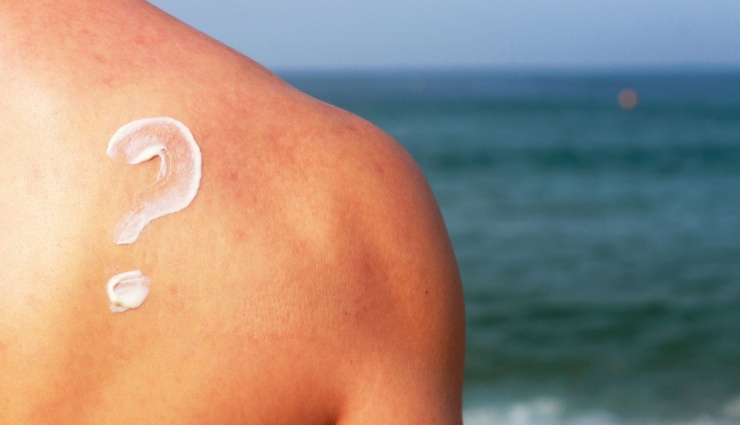The beginning of summer is a perfect time to re-evaluate the sunscreens we use. The most effective way to prevent sun damage to the skin is to avoid sun or use sunscreen creams. When it is impossible to stay away from the sun, it is better to have a suitable sunscreen. Do not forget that the best thing we have to protect the surface of the skin and many layers below it is this sunscreen. We talked to several dermatologists and researched to clarify some confusion about choosing the right sunscreen and what SPF numbers mean. In the following, we will share the results of this research with you and answer ten frequently asked and important questions about sunscreen.
1. What is the importance of SPF in sunscreen creams?
SPF stands for sun protection. The higher this number is, the less sunlight passes through it. Sunscreen cream with SPF 30, if used as prescribed by the doctor, prevents 97% of UVB rays from reaching your skin. Remember that higher SPFs offer more protection but don’t last longer.
Dr. Fayne Frey, a dermatologist in New York, says, “No sunscreen is 100% effective at preventing burning and skin damage, but the best sunscreen can increase the amount of time you can be outdoors.” On the other hand, the length of time that sunscreen protects the skin is somewhat related to SPF.
Recent research shows that the minimum SPF needed to protect the skin is 30, and SPF 100 is more powerful than SPF 50 to protect the skin from damage and sunburn. “Because sunscreens with a higher SPF tend to be stickier, some people aren’t too keen on using them, but the extra protection is worth it, and I recommend it if the amount of sun exposure on a particular day or where you live is very high,” says Dr. Frey. “You have too much; use sunscreen with a higher SPF.”
2. How to protect against UVA and UVB?
The sun emits different types of rays, two of which are the first to cause damage to your skin: ultraviolet A or UVA and ultraviolet B or UVB. UVB rays are shorter than UVA and cannot penetrate glass, but can cause sunburn. UVA rays can pass through glass and are very insidious and dangerous because they burn the layers of your skin even when you can’t feel them burning.
As a result, you should make sure that your sunscreen says “broad spectrum,” “UVA/UVB protection,” or “multispectrum.” Dr. Monique Chheda, a dermatologist in Washington, says, “The two most common UVA protection agents are avobenzone and zinc oxide. So ensure your sunscreen contains at least one of these two ingredients.”
Since UVB and UVA rays cause skin cancer and signs of aging, we suggest you always choose a broad-spectrum sunscreen with at least SPF 30.
3. What is the difference between physical (mineral) and chemical sunscreens?
The terms “physical” or “mineral” and “chemical” are used to describe sunscreens and refer to the active ingredients used in making the sunscreen. Since zinc oxide and titanium dioxide are technically chemicals, it’s more accurate to call physical sunscreens “inorganic” and chemical sunscreens “organic.” Also, there is only a 5-10% difference in how these two types of sunscreen work because they absorb UV rays.
Physical sunscreen (inorganic)
Only two inorganic sunscreen ingredients have been approved by the FDA: zinc oxide and titanium dioxide. It is commonly believed that inorganic sunscreens create a protective barrier on the skin’s surface that reflects UV rays and thus protects the skin. However, recent research shows that inorganic sunscreens absorb 95% of the rays from the sun. They protect the skin.
Physical sunscreens usually leave a white cast unless you use a tinted product or one that uses nanotechnology to break down the particles. Also, while physical sunscreens are labeled as “natural,” most aren’t and must be processed with synthetic chemicals to sit nicely on your skin.
Chemical sunscreen (organic)
All active ingredients that are not zinc or titanium are considered sunscreen chemicals. Chemical sunscreens absorb into your skin instead of forming a barrier on top of it like lotion. Dr. Chida explains that “these active ingredients convert UV light into heat during a chemical reaction so that it does not damage the skin.”
Dr. Chida encourages her patients to use whatever type of sunscreen they prefer but cautions that when choosing an utterly inorganic sunscreen, look for one with at least 10% zinc oxide to provide broad coverage.
4. How often should I apply sunscreen?
“I wear sunscreen 365 days a year, and I’ve made it a habit to apply sunscreen every morning after I brush my teeth,” says Dr. Frey.
It doesn’t matter how many hours you will be in the sun; You need to ensure you use enough sunscreen to be effective. Dr. Frey and Chida both say that the average person wearing a swimsuit needs 1 ounce, or 28 grams, of sunscreen to cover all sun-exposed areas (including the face) and should reapply every 2 hours. If you are going to spend a day at the beach with your family (for example, 6 hours in the sun), each person needs at least 85 grams of sunscreen. If you are not going to swim, it is better to cover yourself with a shirt and a hat and sit in the shade.
People with dark skin color and those who tan easily should not neglect to use sunscreen. Your skin tone should not dictate how much sunscreen you use. Dr. Chida advises that everyone should use adequate sunscreen regardless of skin tone. Skin cancer cure and survival rates are lower for people of color than for white people, possibly due to a lack of screening tests or the belief that darker skin does not need sunscreen.
5. Do we need to use sunscreen when we are at home?
Even if you are not going to spend your afternoon at the park or swimming pool, there is still the possibility of exposure to UV rays. Doors and windows are all openings for sunlight to enter the house. Daily use of sunscreen can significantly reduce the risk of skin cancer and signs of skin aging, such as wrinkles and dark spots.
Always reapply sunscreen and if you are outside, do it every 2 hours. The sunscreen you put on first thing in the morning will wash off during the day.
It also takes about 20 minutes for the sunscreen to work. Of course, if your sunscreen contains more concentrated zinc oxide, you may be able to extend the extension time, but if you’re not sure, don’t risk it!
6. Is there a difference between face and body sunscreen?

According to experts, the only real difference between face and body sunscreen is the size of the bottle it’s sold in. Although the added ingredients in some products are great for your face and body, your face is more sensitive than the rest of your body. The choice of many people is to use a lightweight, non-greasy sunscreen that is formulated for the front and everyday use. This sunscreen model is less likely to clog pores, cause pimples, and irritate the skin.
Avoid using sunscreen sprays on your face because they are not safe to inhale.
7. Is the sunscreen for children and babies different from adults?
Dermatologists recommend non-organic sunscreens for babies, children, and people with sensitive skin. Using such sunscreens reduces the possibility of hives or other allergic reactions. For children, it is better to use a hypoallergenic sunscreen with a zinc oxide formulation, such as Thinkbaby SPF 50. It can be difficult for children to use sunscreen, so a sunscreen spray with SPF 30 is better.
8. Should I be concerned about harmful ingredients in sunscreen?
All the dermatologists we spoke to emphasized that the FDA has rigorously tested the active ingredients in sunscreens. They agree that excessive absorption of chemicals causes skin irritation. So, if you have eczema or hives or are prone to allergic reactions, use sunscreens that contain zinc oxide and titanium dioxide. Scented sunscreens are also irritating for many people, so using a fragrance-free, hypoallergenic physical sunscreen is best.
9. Does sunscreen have an expiration date?
We discussed this in detail in the article Does sunscreen spoil, so here we will only talk about the expiration date.
Sunscreen ingredients break down over time; Therefore, paying attention to the product’s expiration date is wise. These substances can cause severe damage to your skin if they break down.
Not all sunscreens have an expiration date, but that doesn’t necessarily mean these products don’t expire. The FDA allows manufacturers who can prove that their product remains stable for over three years to avoid listing an expiration date on the package. So if your sunscreen has no expiration date, write down the date of purchase and throw it away before three years.
10. Does sunscreen limit vitamin D intake?
Using sunscreen can reduce the amount of vitamin D you get through your skin. These substances essentially prevent sunlight from reaching your skin. A 2017 study found that sunscreens with an SPF higher than 50 reduced vitamin D absorption by 92.5%. The same study further showed that the vitamin D level in the blood decreased by only 7 to 13 percent. This indicates that the body of people in this research has found another way to compensate for vitamin D that you don’t get from sunlight.
last word
Now we know that using sunscreen creams has many benefits, and there is no need to worry about reducing vitamin D in the body, but what is essential is the constant and correct use of sunscreen. If you have a favorite sunscreen that suits your skin well, be sure to share it with us in the comments so that readers of this article can benefit from your experience.
Warning! This article is only for educational purposes; to use it, it is necessary to consult a doctor or specialist.



